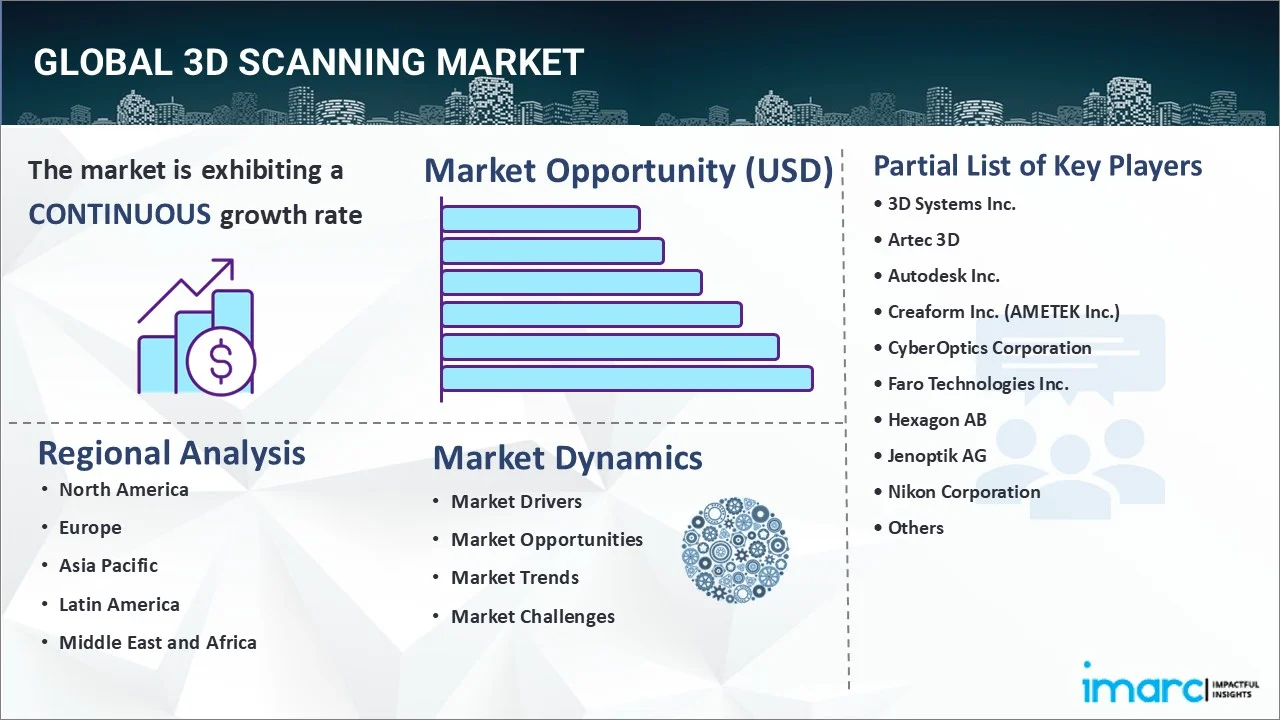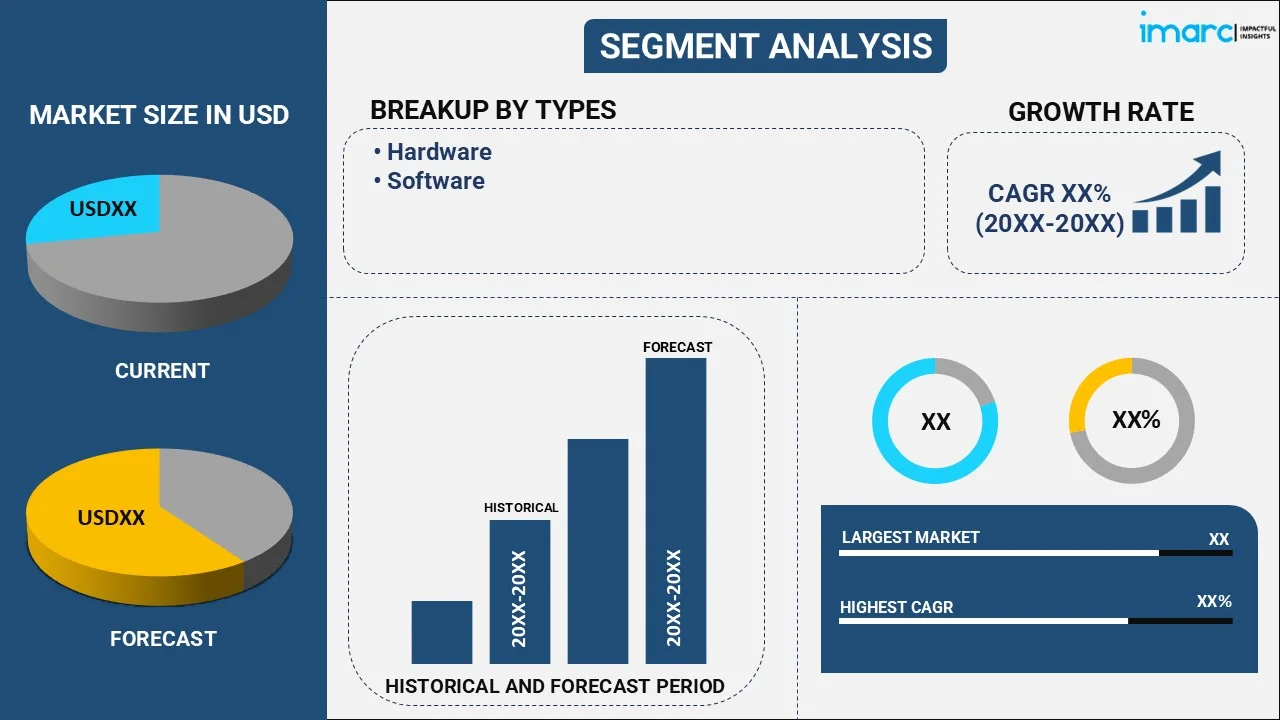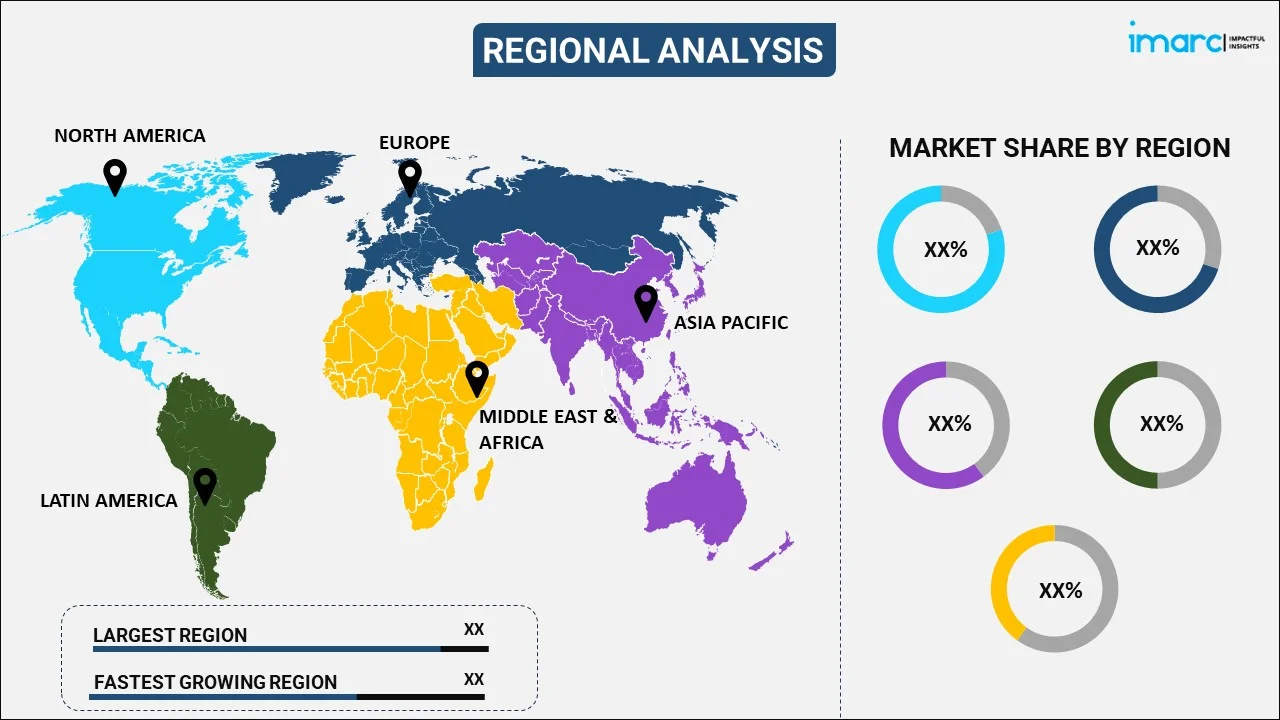
3D Scanning Market Report by Type (Hardware, Software), Range (Short Range, Medium Range, Long Range), Application (Reverse Engineering, Rapid Prototyping, Quality Control/Inspection, Face and Body Scanning, and Others), End Use Industry (Aerospace and Defense, Automotive, Healthcare, Manufacturing, Media and Entertainment, Architecture and Construction, and Others), and Region 2025-2033
Market Overview:
The global 3D scanning market size reached USD 7.2 Billion in 2024. Looking forward, IMARC Group expects the market to reach USD 14.1 Billion by 2033, exhibiting a growth rate (CAGR) of 7.32% during 2025-2033.
|
Report Attribute
|
Key Statistics
|
|---|---|
|
Base Year
|
2024
|
|
Forecast Years
|
2025-2033
|
|
Historical Years
|
2019-2024
|
|
Market Size in 2024
|
USD 7.2 Billion |
|
Market Forecast in 2033
|
USD 14.1 Billion |
| Market Growth Rate 2025-2033 | 7.32% |
3D scanning aids in digitally recreating information about physical components in a simulated world with accurate dimensions by gathering raw data as point cloud information and converting them into computer-aided design (CAD). It enables the complete product form to be checked with the initial CAD template and finds immediate variations with the data shown on a color map with a 3D variance. As a result, it is employed in the automotive, aerospace, and manufacturing industries worldwide. 3D scanning is also utilized by design engineers and technologists to accelerate decision-making in product creation or preparation of plant construction and operations.

3D Scanning Market Trends:
Rising advancements in 3D scanning technology represent one of the key factors impelling the growth of the market. Moreover, medical practitioners conventionally measure body shape and size by hand or devices to diagnose health status and decide treatment. However, 3D scanning technology helps capture 3D measurements without physical contact and consequently finds extensive applications in the healthcare industry. It helps produce medical devices, such as custom-made prosthetics, precise surgical blades, braces, implants, and wheelchairs. This technology is compatible with computed tomography (CT) and magnetic resonance imaging (MRI), which can be used to enhance patient treatment. Apart from this, 3D scanning technology is utilized in the education sector as it encourages interaction and allows students to experiment with modeling core disciplinary topics from the life sciences, including topography, body processes, and molecules. In addition, 3D scanners measure the finest detail of an object, capture free-form, and create precise cloud points for complex geometry and circular surface objects. This, coupled with the burgeoning media and entertainment industry, is strengthening the growth of the market.
Key Market Segmentation:
IMARC Group provides an analysis of the key trends in each sub-segment of the global 3D scanning market report, along with forecasts at the global, regional and country level from 2025-2033. Our report has categorized the market based on type, range, application and end use industry.
Breakup by Type:

- Hardware
- Optical Scanners
- Structured Light Scanners
- Laser Scanners
- Others
- Software
Breakup by Range:
- Short Range
- Medium Range
- Long Range
Breakup by Application:
- Reverse Engineering
- Rapid Prototyping
- Quality Control/Inspection
- Face and Body Scanning
- Others
Breakup by End Use Industry:
- Aerospace and Defense
- Automotive
- Healthcare
- Manufacturing
- Media and Entertainment
- Architecture and Construction
- Others
Breakup by Region:

- North America
- United States
- Canada
- Asia-Pacific
- China
- Japan
- India
- South Korea
- Australia
- Indonesia
- Others
- Europe
- Germany
- France
- United Kingdom
- Italy
- Spain
- Russia
- Others
- Latin America
- Brazil
- Mexico
- Others
- Middle East and Africa
Competitive Landscape:
The competitive landscape of the industry has also been examined along with the profiles of the key players being 3D Systems Inc., Artec 3D, Autodesk Inc., Creaform Inc. (AMETEK Inc.), CyberOptics Corporation, Faro Technologies Inc., Hexagon AB, Jenoptik AG, Nikon Corporation, Topcon Corporation, Trimble Inc and ZEISS Group.
Report Scope:
| Report Features | Details |
|---|---|
| Base Year of the Analysis | 2024 |
| Historical Period | 2019-2024 |
| Forecast Period | 2025-2033 |
| Units | Billion USD |
| Segment Coverage | Type, Range, Application, End Use Industry, Region |
| Region Covered | Asia Pacific, Europe, North America, Latin America, Middle East and Africa |
| Countries Covered | United States, Canada, Germany, France, United Kingdom, Italy, Spain, Russia, China, Japan, India, South Korea, Australia, Indonesia, Brazil, Mexico |
| Companies Covered | 3D Systems Inc., Artec 3D, Autodesk Inc., Creaform Inc. (AMETEK Inc.), CyberOptics Corporation, Faro Technologies Inc., Hexagon AB, Jenoptik AG, Nikon Corporation, Topcon Corporation, Trimble Inc and ZEISS Group. |
| Customization Scope | 10% Free Customization |
| Post-Sale Analyst Support | 10-12 Weeks |
| Delivery Format | PDF and Excel through Email (We can also provide the editable version of the report in PPT/Word format on special request) |
Key Questions Answered in This Report
The global 3D scanning market was valued at USD 7.2 Billion in 2024.
We expect the global 3D scanning market to exhibit a CAGR of 7.32% during 2025-2033.
The growing usage of 3D scanners by design engineers and technologists to accelerate decision-making in product creation as well as in preparation of plant construction and operations is primarily driving the global 3D scanning market.
The sudden outbreak of the COVID-19 pandemic has led to the escalating adoption of 3D scanning technology across the healthcare sector, owing to its compatibility with various medical devices, such as CT scan and MRI to enhance patient treatment.
Based on the type, the global 3D scanning market has been divided into hardware and software. Currently, hardware exhibits a clear dominance in the market.
Based on the range, the global 3D scanning market can be categorized into short range, medium range, and long range, where short range holds the majority of the global market share.
Based on the application, the global 3D scanning market has been segmented into reverse engineering, rapid prototyping, quality control/inspection, face and body scanning, and others. Among these, quality control/inspection represents the largest market share.
Based on the end use industry, the global 3D scanning market can be bifurcated into aerospace and defense, automotive, healthcare, manufacturing, media and entertainment, architecture and construction, and others. Currently, the automotive industry accounts for the majority of the total market share.
On a regional level, the market has been classified into North America, Europe, Asia-Pacific, Middle East and Africa, and Latin America, where North America currently dominates the global market.
Some of the major players in the global 3D scanning market include 3D Systems Inc., Artec 3D, Autodesk Inc., Creaform Inc. (AMETEK Inc.), CyberOptics Corporation, Faro Technologies Inc., Hexagon AB, Jenoptik AG, Nikon Corporation, Topcon Corporation, Trimble Inc, and ZEISS Group.
Need more help?
- Speak to our experienced analysts for insights on the current market scenarios.
- Include additional segments and countries to customize the report as per your requirement.
- Gain an unparalleled competitive advantage in your domain by understanding how to utilize the report and positively impacting your operations and revenue.
- For further assistance, please connect with our analysts.
 Inquire Before Buying
Inquire Before Buying
 Speak to an Analyst
Speak to an Analyst
 Request Brochure
Request Brochure
 Request Customization
Request Customization




.webp)




.webp)












